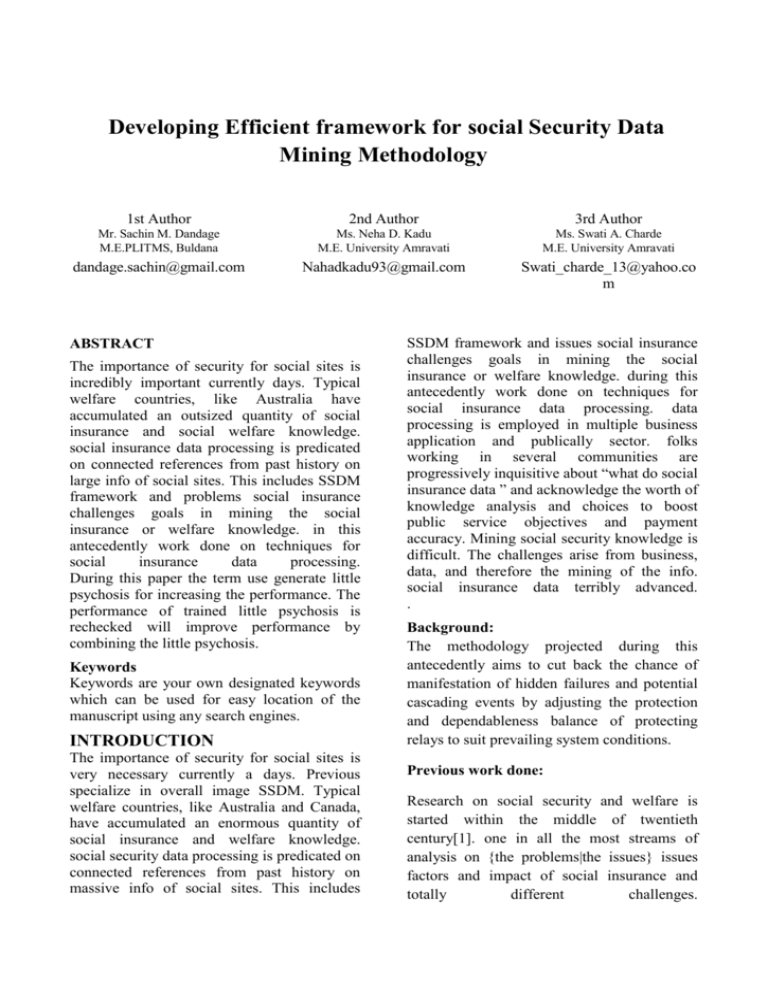introduction - Academic Science,International Journal of Computer
advertisement

Developing Efficient framework for social Security Data
Mining Methodology
1st Author
2nd Author
3rd Author
Mr. Sachin M. Dandage
M.E.PLITMS, Buldana
Ms. Neha D. Kadu
M.E. University Amravati
Ms. Swati A. Charde
M.E. University Amravati
dandage.sachin@gmail.com
Nahadkadu93@gmail.com
Swati_charde_13@yahoo.co
m
ABSTRACT
The importance of security for social sites is
incredibly important currently days. Typical
welfare countries, like Australia have
accumulated an outsized quantity of social
insurance and social welfare knowledge.
social insurance data processing is predicated
on connected references from past history on
large info of social sites. This includes SSDM
framework and problems social insurance
challenges goals in mining the social
insurance or welfare knowledge. in this
antecedently work done on techniques for
social
insurance
data
processing.
During this paper the term use generate little
psychosis for increasing the performance. The
performance of trained little psychosis is
rechecked will improve performance by
combining the little psychosis.
Keywords
Keywords are your own designated keywords
which can be used for easy location of the
manuscript using any search engines.
INTRODUCTION
The importance of security for social sites is
very necessary currently a days. Previous
specialize in overall image SSDM. Typical
welfare countries, like Australia and Canada,
have accumulated an enormous quantity of
social insurance and welfare knowledge.
social security data processing is predicated on
connected references from past history on
massive info of social sites. This includes
SSDM framework and issues social insurance
challenges goals in mining the social
insurance or welfare knowledge. during this
antecedently work done on techniques for
social insurance data processing. data
processing is employed in multiple business
application and publically sector. folks
working in several communities are
progressively inquisitive about “what do social
insurance data ” and acknowledge the worth of
knowledge analysis and choices to boost
public service objectives and payment
accuracy. Mining social security knowledge is
difficult. The challenges arise from business,
data, and therefore the mining of the info.
social insurance data terribly advanced.
.
Background:
The methodology projected during this
antecedently aims to cut back the chance of
manifestation of hidden failures and potential
cascading events by adjusting the protection
and dependableness balance of protecting
relays to suit prevailing system conditions.
Previous work done:
Research on social security and welfare is
started within the middle of twentieth
century[1]. one in all the most streams of
analysis on {the problems|the issues} issues
factors and impact of social insurance and
totally
different
challenges.
within the economic perspective the dominant
reality and trend is that the exploration of
issues from the point of view of economic. In
social science perspective researches are
concern regarding the protection methodology
on society[2]. In regional perspectives
researches from totally different countries
introduce the progress of social insurance in
their individual countries. In technical
perspective Associate in Nursing rising trend
in social security is that the study of technical
problems like infrastructure development
information management and challenges.
A abstract summary of the advocated adaptive
protection theme is completed. The choice
theme consists of a collection of 3 freelance
and
redundant
relays.
Wide-area
measurements are obtained with the guidance
of PMUs. The underlying hypothesis is that
phasor measurements at strategic buses offer
enough info to discriminate the requirement
for a bias toward security. These
measurements ar accustomed infer the state of
the facility system that are classified as either
“stressed” or “safe.” The system is found to be
stressed if the right course of action is to
enable the choice theme. Previous studies on
PMU measurement-based on-line DSA
implicitly suppose that wide space observance
systems
(WAMS)
provide
reliable
measurements. However, in on-line DSA,
PMU
measurements
will
become
unprocurable owing to the sudden failure of
the PMUs or due to loss of the communication
links. Recently, it's been recognized on
massive scale that PMU failure are often a
very important issue that impacts the
performance of WAMS. Methodology exists
that shares the complex knowledge with
AIDA i.e. Anonymous ID Assignment [5].
Algorithms are existing for locating AIDA.
Existing Methodologies:
The thought of secure add exists with the help
of secure add will transmit easy knowledge
with power add. Methodology exists that
shares the complex knowledge with AIDA i.e.
Anonymous ID Assignment [5]. Algorithms
are existing for locating AIDA. method
mining techniques offer to discover, monitor
and improve processes. The analysis of
services done mistreatment method mining
that
contain
method
discovery,
correspondence
checking
and
model
sweetening [3]. Methodology for security or
dependability adaptive protection theme ar
exist and it's concern with deciding the PMU
placement, process Associate in Nursing
objective perform to classify the system state
into stressed or safe, identifying measurements
are a lot of adept at classifying the system
state and last one is process the decision logic
to change the protection or dependableness
bias of adaptive protection theme [4]. A
hidden failure is defined as a permanent defect
on a relay system that may cause the wrong
removal of a circuit part as an instantaneous
consequence of another event [2]. As sent by
the definition, hidden failures stay dormant till
a selected event causes its manifestation and
associated relay is operation. The modes of
hidden failures ar a perform of the relay kind
(i.e., {different| totally different|completely
different} protection schemes ar vulnerable to
different hidden failures). Performance ,
improvement, social insurance business and
social insurance knowledge are existed[1].
Analysis and Discussion:
Analysis on Existing methodology: Slot
choice AIDA formula has main disadvantage
the terribly long message length. To avoid the
Newton polynomial entirely use the Sturm’s
Theorem AIDA. it's not competitive with
methods of polynomial solutions. Basic
framework lists the most objectives together
with client service sweetening. In hidden
failures the analysis of the various modes is
highly correlative with the logical diagram of
the protecting theme. a close description of the
different modes of hidden failures for every
relay kind are often found. The length of the
region of vulnerability could be a perform of
the relay type, the relay settings, and therefore
the topology of {the knowledge|the info|the
information} Mining: DTS: {data mining|data
methoding} is outlined because the process of
discovering similar and totally different
patterns in data. A DT could be a type of
inductive learning. Given a knowledge set, the
target is to make a model that captures the
mechanism that gave rise to the data (i.e., we
tend to don't seem to be attempting to model
the info itself however the underlying
mechanism that gave rise to
data).
Trends of improvement: The business
objective layer includes the main aims and
includes client service sweetening (to instantly
offer high-quality services to those with
explicit
needs),
payment
correctness
sweetening (e.g., to pay to improve quantity to
those that ar eligible), business integrity
sweetening (e.g., to boost the consistency and
accuracy and to speed up processing), debt
management and interference (e.g., to recover
and stop debt instantly), outlays cause
identification (e.g., to spot outlays incurred by
workers error), financial gain transparency
improvement (e.g., the main client earnings
reportage and to notice grey financial gain
automatically), performance to improve (e.g.,
to cut back client waiting time in commission
centers or decision centers), service delivery
sweetening (e.g., to strip out unnecessary
contacts and supply easier and a lot of
economical pathways to services), service/risk
identification (e.g., to spot customers most at
risk of incorrect payments and to spot
opportunities to cut back the debt a lot of
efficiently), client would like satisfaction.
Comparison and Drawback: This fact
permits the model to transcend the actual
knowledge set accustomed grow the DT and to
form inferences on new data. psychosis ar
adult through a scientific method called
algorithmic binary partitioning; a “divide-andconquer” approach wherever ordered queries
with affirmative or no answers ar asked so as
to partition the sample area. the target is to
recursively partition the sample area so as to
extract the knowledge exhibited in knowledge
regularity patterns.
Proposed Methodology:
Degenerate little psychosis (Decision Trees):
A degenerate little DT is obtained by
collapsing the sub tree of an enclosed node
with missing PMU measurement into a leaf
node. Specifically, a tiny low DT degenerates
to a non-empty tree. if the PMU measurements
utilized by the interior nodes apart from the
basis node are missing. The new leaf node of
the degenerate little DT is assigned identical
call because the original internal node.
Therefore, for a non-empty degenerate small
DT, the re-check results on the new cases
might be simply obtained.
Class = S
Q_12_16<=
26.45
Class = S
CTNO$=CT
45
Class = I
Class = S
A_11_9<=5.
8
Class = S
Class = I
Class = I
Fig: Example of full-grown DT of height
Class = S
Q_12_16<=
26.45
Class = S
CTNO$=CT
45
Class =
S
psychosis, whereas in the projected approach,
the new cases ar solely accustomed re-check
the performance of viable little psychosis
therefore on quantify the voting weight
Future scope:
Class = I
Class = I
Fig: Example of small DTs of above fully
grown decision tree.
Possible
Outcomes
and
Results:
Small psychosis has less height. a tiny low
psychosis may have less accuracy than fullgrown call trees. however it's simple to take
call. And multiple call trees are often
combined to extend the accuracy. therefore
degenerating little psychosis are often used
like
divide
and
conquer
rule.
Conclusion:
little psychosis are utilized in each
approaches; new cases are employed in close
to time period for accuracy guarantee by both
approaches; the protection classification
choices of on-line DSA are each obtained via
a weighted voting of little psychosis.
However, the 2 approaches are tailored
towards totally different application scenarios.
The approach projected here is a lot of sturdy
to
missing
PMU
measurements.
The little psychosis in the projected approach
are trained by mistreatment attribute subsets
for hardiness, whereas the whole set of
attributes is used in a very data processing
framework for on-line dynamic security
assessment. Second, the usage of recent cases
in close to real-time is totally different. The
new cases ar accustomed update the little
during this there's future scope for robust online dynamic security assessment , for
developing sturdy on-line dynamic security
might use adaptive ensemble decision tree
learning. within the offline coaching , a
boosting formula is used to make a
classification model as a weighted voting of
multiple unprimed little height psychosis.
References:
[1] Longbing Cao “Social Security and
Welfare data processing : Associate in
Nursing overview” IEEE Trans on system and
IP, Vol.42 No.6 p.p. 837-853, Nov 2012.
[2] Virgilio Centeno , James S. Thorp,
Emanual E. Bernabeu “Methodology for a
Security/Dependability adaptative Protection
theme supported knowledge Mining” IEEE
Trans on power delivery,vol. 27, No. 1, p.p.
104-111,
Jan
2012.
[3] Wil van der Aalst “Service Mining :
mistreatment method Mining to get, check and
Improve service Behavior” IEEE Trans on
Services Computing, Vol. 6, No. 4,p.p. 525535,
Oct-Dec
2013.
[4] Miao He, Vijay Vittal and Junshan Zhang
“Online Dynamic security Assessment With
Missing PMU Measurements: a knowledge
Mining Approach” IEEE Transactions on
power grid, vol.28, No. 2,P.P. 1969-1977,
May
2013.
[5] Larry A. Dunning and Ray Kresman
“Privacy conserving knowledge sharing with
anonymous ID assignment” IEEE Trans on
info Fornsics and Security, VOL. 8, NO. 2
p.p. 402-413, Feb 2013.
Degenerate little psychosis (Decision Trees):
A degenerate little DT is obtained by
collapsing the sub tree of an enclosed node
with missing PMU measurement into a leaf
node. Specifically, a tiny low DT degenerates
to a non-empty tree. if the PMU measurements
utilized by the interior nodes apart from the
basis node are missing. The new leaf node of
the degenerate little DT is assigned identical
call because the original internal node.
Therefore, for a non-empty degenerate small
DT, the re-check results on the new cases
might
be
simply
obtained.






